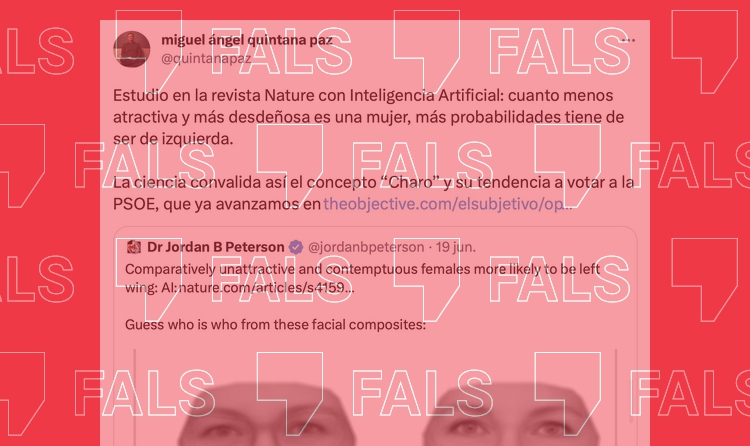No article in Nature magazine has shown that conservative women are more physically attractive

The machine correctly guessed the ideology 61% of the time: only a little more than every one in two times

There is currently a claim making the rounds on social media that Nature magazine supposedly published a study in which some academics demonstrated, thanks to artificial intelligence, that “comparatively unattractive and contemptuous females [are] more likely to be left wing”.
This claim is FALSE. The document they are referring to was published in Scientific Reports, an open-access journal with less prestige and impact than Nature, but that is part of the same group. What the study is actually analysing is that certain facial features allow a machine to detect a person’s ideology. However, the trials were carried out in a reduced sample of 3,288 candidates made up of Danish politicians, i.e. the results cannot be extrapolated to the entire population.
What’s more, the machine correctly guessed the ideology 61% of the time (only a little more than every one in two times, which is what chance does), which, according to the experts we consulted, is not an acceptable level of accuracy to affirm that artificial intelligence can correlate facial expressions with political ideology. Nowhere in the study does it define the concept of beauty.
A study with artificial intelligence in Nature magazine: the more unattractive and contemptuous a woman is, the higher the chances she is left wing
The study was published on 31 March and its publication did not make much of an impact. So why, all of a sudden, almost three months later, are so many people using it to say that women on the political left are uglier? The origin of the disinformation is in a tweet shared by Jordan Peterson, a public figure known within the world of disinformation and who has been fact-checked by other members of the International Fact-Checking Network, such as AAP and AFP Fact Check. The Canadian influencer stated on 19 June that “comparatively unattractive and contemptuous females [are] more likely to be left wing”, citing the study.
However, according to an email that Robert Klemmensen, professor of Comparative Politics at the University of Lund (Sweden) and one of the other authors of the study, wrote to Verificat, the study’s conclusions have little to do with the interpretations of the aforementioned claims: they were investigating “whether masculinity, beauty scores or facial expressions could be important for the machine-learning algorithm to predict whether the person was on the left or the right politically”.
Once the faces were processed – and, by the way, they were Danish politicians, which means that the results cannot be generalised to apply to the rest of the world’s population – the machine observed that, effectively, the female candidates with the highest beauty scores coincided with those on the right.
This does not necessarily mean that they are more attractive per se, but it suggests, according to Klemmensen, that “politicians know which facial expressions are most desirable to a certain group of the electorate”. The problem with all of this is that the machine did not guess much better than if we were to flip a coin and predict a random result.
Like flipping a coin
The algorithm guessed correctly 61% of the time, which is “only 10% more of the time than flipping a coin”, Ana Valdivia, mathematician and lecturer in AI, Government and Policy at the Oxford Internet Institute (OII) in the UK, explains to Verificat. This success rate, paired with the limited sample size of the test set (164 women), differs little from a result yielded by chance.
To determine whether a model is better or worse, the experts usually establish a scale: “Less than 60% is poor; between 60% and 70% is sufficient; between 70% and 90% is good; more than 90% is very good”, concludes Miguel Rebollo, who earned a PhD in Artificial Intelligence and Complex Systems, and is a professor at the Polytechnical University of Valencia (UPV).
What is meant by attractive?
One of the biggest criticisms of this study is that it links a person’s physical attractiveness with a specific ideological stance. “Deep learning (DL) cannot evaluate if someone is attractive or not”, Valdivia states, adding that both attractiveness and beauty are “very subjective concepts”.
In the study, the expert adds, “the authors do not provide a definition of attractiveness or beauty” and instead use another study in which they label “the human faces of politicians based on 60 people’s perception of the beauty of human faces”.
Be wary of studies that correlate personality with physical appearance
The expert reminds us that this type of study could be related to phrenology, which is considered a pseudoscience today: “There is a long tradition of AI and physiognomy studies that claim that AI ‘predicts’ gender or sexual orientation based on human faces. However, there is no scientific evidence that can prove whether these studies are sound or not”.
Fernando Blanco, professor of Social Psychology at the University of Granada (UGR), agrees with her. He stresses that, above all, the problem is that it is a belief “with clear dangers of producing discrimination” and warns that these ideas are currently “experiencing a big revival” thanks to artificial intelligence.